Matador Network's Blog, page 72
January 31, 2025
Carnival Cruise Line Owns an Entire Port and Beach in Honduras
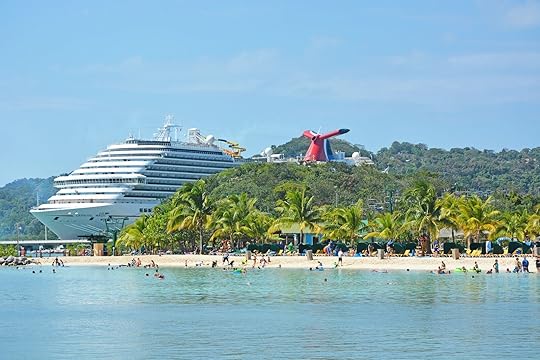
See the full list of islands and beaches owned by cruise lines
Carnival Cruise Line financed the 20-acre Mahogany Bay Cruise Ship Port and Center which opened in 2011. As such, only cruise lines that operate under the umbrella of the Carnival Corporation & plc are allowed to dock in Mahogany Bay, including Carnival Cruise Line, Princess Cruise Line, Holland America Cruise Line, Costa Cruise Line, P&O Cruise Line, and more. The Mahogany Bay Cruise Center is home to numerous shops, and food-and-drink venues; it is also the meeting point for shore excursions and the access point (on foot via a bridge or via a fee-based chairlift) to the adjacent island where Mahogany Beach is located.
Cruise travelers who want to relax on the white sand of Mahogany Beach can enjoy complimentary beach loungers and mats, and can rent watersport equipment, and air-conditioned, beachfront cabanas that are fully furnished with all the beach essentials. Roatán shore excursions are available through cruise lines, including horseback riding, snorkeling, sailing, wildlife-watching tours, and more.
Take a look at the cruise schedule to see what cruise ships visit Mahogany Bay and when, and book accordingly. 
Paul Gauguin Cruises Owns a Dreamy Island in French Polynesia
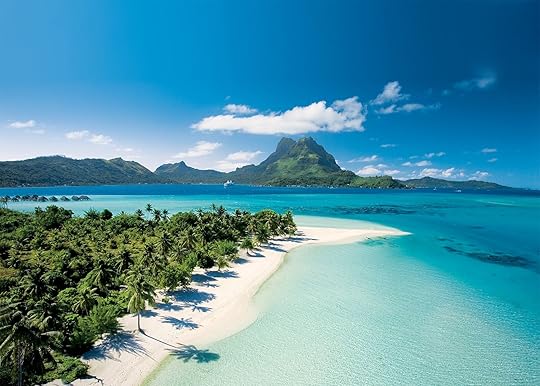
See the full list of islands and beaches owned by cruise lines
Luxury cruise line Paul Gauguin Cruises, which consists of only one ship, the m/s Paul Gauguin, operates principally in French Polynesia and even owns an islet in the region: Motu Mahana. Motu Mahana is a very small, but beautiful, uninhabited island in the archipelago of the Society Islands, which the m/s Paul Gauguin visits frequently. The m/s Paul Gauguin cannot dock at Motu Mahana so guests are transported from the ship to the island via tenders. Once on the island for the day, guests can take advantage of the beach loungers and umbrellas to relax, and partake in a variety of activities, including kayaking, snorkeling, swimming, beach volleyball, and even a pareo-tying demonstration. During their time on Motu Mahana, guests enjoy a barbecue meal and refreshments from floating bars throughout the day. All the activities are included in the cruise fare, except for the overwater massage which comes at an additional fee. 
January 30, 2025
13 Small French Towns Every Wine Lover Should Have on Their Travel List

For winer lovers, few places are more iconic than France. Here, wine isn’t just a beverage, it’s a millennia-old tradition that is an important part of every meal and celebration. Wine defines the country’s landscape, the population’s livelihood, and even the calendar. Travelers can experience a remarkable breadth of wine culture in France’s biggest cities — Paris, Lyon, Bordeaux, Nantes, Strasbourg — but the wine trips that stand out most are in the small towns that surround the country’s most famous vineyards and viticultural areas. That’s because in addition to the tastings and access to wines not found elsewhere, visitors can often walk among the vines and meet winemakers in beautiful, historical settings.
Getting off the tourist track and bumping along country roads to reach these 13 small towns is more than worth it for wine lovers.
Contributors: Morgane Croissant, Suzie Dundas, Katie Gavin, Nickolaus Hines, Tim Wenger
We hope you love the stays we recommend! Just so you know, Matador may collect a small commission from the links on this page if you decide to book.
Jump to:
Beaune, Côte-d’Or
Bergerac, Dordogne
Cahors, Lot
Châteauneuf-du-Pape, Vaucluse
Chinon, Indre-et-Loire
Clisson, Loire-Atlantique
Cognac, Charente
Hautvillers, Marne
Montreuil-Bellay, Maine-et-Loire
Olmeto, Corse-du-Sud
Riquewihr, Haut Rhin
Saint-Émilion, Gironde
Villeneuvette, Hérault

Photo: tichr/Shutterstock
Why we love it: A center of Burgundy’s wine production and trade with a deep historyWhat wines to try: Chardonnay and pinot noirBest place to stay: L’Hôtel de BeauneBurgundy’s place in wine history is no secret. The region is one of the most famous in France for the high quality wines produced and exported from here since at least the 1400s (though like much of France, vineyards were introduced by the Ancient Romans more than 1,000 years earlier and they, too, recognized how the area has prime grape-growing conditions). Catholic monks managed the vineyards and studied the best land for grapes through the Middle Ages for wines for the church and the Dukes of Burgundy. After the French Revolution, the land went back to the people. Location and terroir play just as important a role today as they did half a millennium ago.
The small town of Beaune has long been at the heart of the wine trade in Burgundy and played a crucial role in moving Burgundian wine around the world. It is also the cultural center of Côte de Beaune (“hills of Beaune”), the largest appellation in the Côte d’Or. Together with the Côte de Nuits to the north, the Côte d’Or is one of the most important regions in Burgundy overall.
There are eight Grand Cru vineyards in Côte de Beaune, and seven focus on white wine: Corton (the red wine exception), Corton Charlemagne, Charlemagne, Montrachet, Chevalier-Montrachet, Bâtard-Montrachet, Bienvenues-Bâtard-Montrachet, Criots-Bâtard-Montrachet. Those join more than 40 Premier Cru vineyards making crisp chardonnays and complex pinot noirs. Despite the chardonnay dominance at the echelon of producers, more than 70 percent of the vineyards in Beaune are dedicated to pinot noir.
Beaune has an impressive amount of tourism infrastructure for a small town thanks to its central role in the wine trade and its reputation among wine lovers. In addition to incredible five-star hotels like L’Hôtel de Beaune, there are plenty of Airbnbs to choose from. Many wineries in and around Beaune offer tours and tastings. Be sure to visit the Hospices de Beaune for a look into the wine commerce history here. While there are certainly enough wineries to fill multiple trip itineraries in Beaune alone, the proximity to classic villages like Meursault and Pommard make Beaune somewhere that can serve as a base for the wider region, too.
By train is the best way to get to Beaune. The local station connects to major cities in France and is about 2.5 hours from Paris. Driving along the A6 is another option, or flying into the Dijon-Bourgogne Airport and driving from there.
Bergerac, Dordogne
Photos: Sergey Kelin/Shutterstock, milosk50/Shutterstock, and milosk50/Shutterstock
Why we love it: A wine-rich region with small crowdsWhat wines to try: Muscadelle in Monbazillac, red blends in PécharmantBest place to stay: Le Clos d’Argenson in the center of town, or Château Feely for a more immersive wine experienceBergerac sits in southwestern France along the Dordogne River. Aside from its wine, the town is known for its well-preserved medieval architecture and half-timbered houses. It’s wine reputation is due to the proximity to two wine appellations: Monbazillac and Pécharmant. Monbazillac produces white wine made from grapes intentionally left on the vine long enough for botrytis (“noble rot”) to create natural sweetness, while Pécharmant is known for its full-bodied reds that age extremely well (so feel free to bring back a case or two).
Bergerac’s historic quarter is filled with cobblestone streets, half-timbered houses, and quaint squares. The Place Pelissière (Pelissière Place) is a central point, often bustling with markets and cafes. It’s small, of course — this isn’t the same type of square you’d find in Rome or Paris — but that’s part of the appeal. Nearby is Quai Cyrano, a central hub for all-things Bergerac wine, including wine tastings, wine events, a local market, and more.
On the outskirts of town, you’ll find more than 150 wineries, with the highest concentration in the Monbazillac Valley, just south of Bergerac. (Pécharmant is to the east). The region’s tourism website has an excellent list of local wineries and details on visiting, so it’s easy to visit yourself if you have a car. But if you’d prefer not to drive, you’ll find plenty of wine tours in the area, and large area wineries like Château Feely offer in-depth tours and tastings that include local pickup from Bergerac.
Cahors, Lot
Photos: Anibal Trejo/Shutterstock and Sergey Novikov/Shutterstock
Why we love it: Historic small town with beautiful medieval architecture, UNESCO-listed sites, and local culinary specialtiesWhat wines to try: MalbecBest place to stay: The Best Western Plus Hôtel Divona Cahors, is not only close to the city center and the Chartreux Fountain, but it has great views on the Valentré BridgeCahors (pronounced kaa-orr) is both the name of a quaint southeastern town of 20,000 people, and that of the wine produced from the grapes that grow around it. Although Cahors, the town, is divided into two parts by the Leon Gambetta Boulevard, the old town and the modern town both have worthy attractions that can easily be visited in a couple of days. Make sure to check out the abundant Roman and medieval architecture, the covered market, and the 900-year-old domed Saint-Étienne Cathedral UNESCO World Heritage site in old town. The 700-year-old market taking place around the cathedral every Saturday is one you don’t want to miss if you’re keen to try local specialties, including duck or goose foie gras, walnut tart, croustilot bread, and pastis, an apple- and prune-based cake. In the modern part of town, check out the underground remains of an ancient Roman amphitheater before crossing the Lot River via the 14th-century UNESCO-listed Valentré Bridge and take a peek at the Chartreux Fountain, where Romans used to worship the goddess Divona.
Culture and food often take a backseat to what this region is best known for: wine.
Cahors is a bold, deep, and dark wine (sometimes called black wine) made from malbec grapes (a variety that is locally called côt). While there are numerous wine producers in the area, travelers to Cahors would be remiss to pass on a visit to Château Eugénie and Château Les Bouysses vineyards, where you can partake in wine tastings.
Châteauneuf-du-Pape, Vaucluse
Photos: Richard Semik/Shutterstock and barmalini/Shutterstock
Why we love it: A medieval village that owes its existence to a former Pope What wines to try: grenache, syrah, and mourvèdreBest place to stay: Hôtel Château des Fines RochesThe village of Châteauneuf-du-Pape (which translates to “new castle of the Pope”) was founded in the early 14th century, when Pope John XXII established the area as a papal residence. The ruins of the castle built under his direction still crowns the village. The wine region here flourished under papal influence, and that tradition continues today. Select wines from the region can fetch some of the highest prices from collectors, though visiting the town means a lot more than spending every penny on an investment wine.
Wines from Châteauneuf-du-Pape are among the most prestigious in the Rhône Valley. The region’s terroir is defined by galets roulés — large, sun-warmed stones that enhance grape ripening. The appellation permits up to 13 grape varieties, with blends of grenache, syrah, and mourvèdre (a mixture often shortened to simply “GSM”) being the most prominent for red wines. Grenache contributes ripe red fruit and spice, syrah adds structure and dark fruit, and mourvèdre imparts complexity and earthy depth. The region also produces outstanding white wines, often blending roussanne, grenache blanc, and clairette for vibrant, aromatic expressions.
If you go, be sure to explore the historic cellars and hire a driver to visit nearby sites like Avignon and the Dentelles de Montmirail.
Chinon, Indre-et-Loire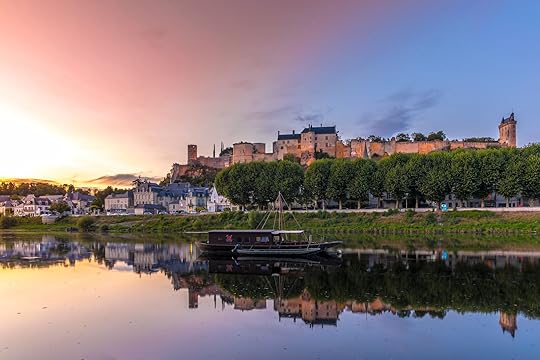
Photo: Sander Meertins Photography/Shutterstock
Why we love it: A historical town close to two of the most beautiful castles in the Loire Valley: Château d’Ussé and Château d’Azay-le-RideauWhat wines to try: Cabernet Franc and chenin blancBest place to stay: The converted horse stable Domaine Pierre et Bertrand CoulyThe small, UNESCO-listed town of Chinon, located on the banks of the Vienne River in France’s Loire Valley, is known for three things: the imposing medieval royal fortress that stands on a rocky outcrop and overlooks the town; the historical edifices that line its narrow streets, including timber-framed houses and 19th-century private mansions; and wine. Chinon is not only the name of the town, it’s also the name of the wine designation.
Chinon producers primarily make red wine using cabernet Franc, though the region also produces smaller amounts of rosé and white wines from chenin grapes. The organically run Domaine de Noiré, only two miles from the city center, is a good place to try Chinon wine, from reds, to whites, to sparkling wines. Book ahead for a guided visit and a tasting. The Domaine Pierre et Bertrand Couly is another nearby vineyard that’s worth visiting — or to extend the visit with a stay at the on-site accommodations.
Clisson, Loire-Atlantique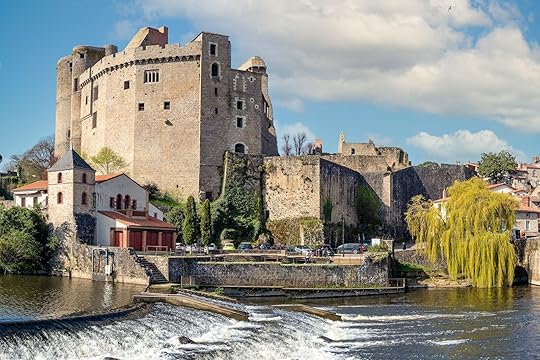
Photo: Rodolphe Antonetti/Shutterstock
Why we love it: An Italian atmosphere and abundance of historic buildingsWhat wines to try: MuscadetBest place to stay: La CascadeLocated in western France along the banks of the Sèvre Nantaise River, Clisson looks a little like a small Tuscan village thanks to its narrow streets and brick houses topped with terra cotta roofs. That’s because in the early 19th century, French sculptor François Fédéric Lemot, a lover of Italian art and architecture, entirely redesigned the then war-torn town. He even built his own Tuscan paradise, La Garenne Lemot, a large property with a beautiful garden that is open to the public.
Clisson’s Italian flair is not its only appeal, however. The small town is full of protected historical buildings that predate Lemot, including Clisson Castle and the medieval covered market where you can try local specialties like fouace nantaise (a star-shaped brioche). There is also a wide variety of events taking place in this small, underrated town, including one of the largest metal music festivals in Europe, Hellfest, that takes place every year in June, and an annual Venice-like masquerade parade that happens in May.
But Clisson’s most attractive facet is undeniably its vineyards that produce dry and crisp white wines with muscadet grapes. The vineyards surrounding the town can be reached by bike, including the organically run Domaine Bregeon just three miles out of Clisson, and the family-owned Domaine Martin-Luneau, a few minutes away. Both offer visits of the vineyard and wine tastings.
Cognac, Charente
Photos: Valery Rokhin/Shutterstock and barmalini/Shutterstock
Why we love it: Wine is an underrated, but important part of this region more famous for its eponymous brandyWhat wines to try: Ugni blanc and colombardBest place to stay: Hôtel Chais MonnetCognac is a name known around the world, though for the eponymous brandy not for wine. Gorgeous hotels, refined restaurants and bars, engaging tours — all are centered on Cognac, the brandy, and make the small village an incredible destination for anyone who loves French spirits. That said, all great brandy starts with great wine. (It’s also worth noting that the term “brandy” comes from the Dutch “brandewijn,” which translates to “burnt wine” in reference to distillation.)
Cognac, located north of Bordeaux, is defined by the Charente river. The river impacts the microclimate, of course, but is also how the region’s brandy became a luxury export good. The wine region is named after the river: IGP Charentais, which is largely the same area designated for brandy. Ugni blanc, folle blanche, and colombard grape varieties are popular for the brandy thanks to the high acidity and low alcohol content, and they make their way into the wines as well. Charentais wine is also made from chardonnay, sauvignon blanc, cabernet sauvignon, merlot, gamay, and pinot noir. The whites are typically dry and floral, while the reds are light and fruity from a terroir defined by chalky limestone soils and a maritime climate.
It isn’t uncommon to be served spirits with meals in Cognac, though more often a regional wine will grace the table with food at restaurants. One beverage unique to the region that you may encounter at farm distilleries or wineries is pineau des Charentes. It’s made by blending fresh, unfermented grape juice with unaged Cognac for a refreshing (and hyper-local) drink.
The closest airport is in Bordeaux, and then Cognac is about an hour-and-a-half drive north. By train, Cognac connects to France’s major cities and is about three hours from Paris. Accommodations, like the premier Hôtel Chais Monnet as well as places like Château Pellisson (and the rustic-chic Airbnbs), understandably have more of a brandy theme than wine theme. That doesn’t make the stunning properties any less attractive for the wine tourist, however.
Hautvillers, Marne
Photos: barmalini/Shutterstock and ChrisMannPhoto/Shutterstock
Why we love it: The town where Dom Pérignon made his remarkable contributions to winemakingWhat wines to try: ChampagneBest place to stay: Champagne Joseph DesruetsHautvilliers, located in the Champagne region and surrounded by vineyards, is no ordinary village even by Champagne standards. It’s known as the “Cradle of Champagne” due to its link with the Benedictine monk Dom Pérignon. The monk is better known for the brand carrying his name these days, and it’s safe to say there would be no Champagne wine as we know it without him.
Dom Pérignon became a monk at the Abbaye Saint-Pierre d’Hautvillers in 1668 and worked as the cellar master until he died in 1715. He played a crucial role in the development of Champagne production and was instrumental in creating the in-bottle secondary fermentation that gives the wine its bubbles and other practices that define the Champagne method still used today. You can visit or take a guided tour of the 12th-century former abbey, which serves as the monk’s final resting place.
If you want to take part in a Champagne tasting but stay within the village, make your way to Entre Cave et Jardin, a mix of antique shop and wine seller. There, the oenologist, formerly a cellar master at a prestigious Champagne house, will gladly take you through a comparative tasting of Champagne styles. For a cellar tour and a tasting, head to the family-run Champagne A.D. Coutelas, a few minutes outside of town, or Champagne A. Chauvet, just 15 minutes away from the village, where you can try out rosé Champagne.
Beyond wine, a stay in Hautvillers offers you a glimpse into the daily life of a Champagne village. You can while away an afternoon strolling the narrow cobblestone streets lined with stone houses with wrought-iron balconies and take in the beautiful countryside.
Montreuil-Bellay, Maine-et-Loire
Photo: leoks/Shutterstock
Why we love it: A small, historic town with a magnificent castleWhat wines to try: Cabernet France, chenin, and chardonnayBest place to stay: Manoir du BellayOne of the prettiest small towns in France, Montreuil-Bellay sits on the bank of the River Thouet in the west of the country. The biggest attraction in town is the impressive medieval fortress. Inside the fortress is the well-preserved 15th-century Montreuil-Bellay Castle, a grand edifice where several of the kings of France have stayed over the centuries, and where 1,200 wounded soldiers were hospitalized during the First World War. Open to the public between April and December, the castle is also where you’ll find some of the best wines in the area made in the Saumur and Crémant de Loire appellations. In the newly renovated wine cellar, the owners keep their vineyard’s production of red, white, rosé, and sparkling wines made primarily with cabernet Franc, chenin, and chardonnay grapes. Visitors can purchase bottles on site and take part in wine tastings. If you wish to see the fortress and the town from a different perspective, rent a canoe, kayak, or pedalboat and spend a couple of hours floating on the river.
For another wine tasting in the area, make your way to the nearby Château de la Durandière, a 17th-century castle surrounded by a large vineyard. You’ll be able to visit the cellar and try out red, white, and sparkling wines. Regardless of where you taste, don’t sleep on the bubbly (crémant), which is made in the Champagne method for wines that rival the more famous sparkling wine region in flavor but not price.
Olmeto, Corse-du-Sud
Photos: Wazir2004/Shutterstock and Evannovostro/Shutterstock
Why we love it: Mediterranean terroir combined with French culinary and viticultural tradition What wines to try: Malvasia, niellucciu, and sciaccarelluBest place to stay: Domaine de MurtoliOlmeto, in Southern Corsica, offers the best of Mediterranean culture: fresh ingredients, stunning natural sights, and fantastic wine. The wine region is situated between rugged mountains and the crystal-clear waters of the Tyrrhenian Sea. Corsica, known as the “Island of Beauty,” is celebrated for its dramatic landscapes, and Omelto exemplifies this and adds a welcoming atmosphere.
The surrounding wine region dates back to antiquity when the Greeks and Romans introduced viticulture to the island. The terroir here is influenced by the island’s diverse microclimates, mineral-rich soils, and coastal breezes, resulting in wines of exceptional character and balance. Corsican wines are primarily produced under the island’s Protected Designation of Origin (PDO), with Ajaccio PDO being the closest appellation to Olmeto.
Key grape varieties in the region include niellucciu and sciaccarellu for reds and rosés with spicy undertones and notes of wild herbs, often referred to as maquis (scrubland) aromas. For whites, vermentino (locally called malvasia) dominates, producing crisp, aromatic wines with citrus and floral notes. You may feel more like you’re in Italy than France, particularly due to the offshore location, but once you taste the cheese, you’ll be reminded of exactly where you are.
Riquewihr, Haut-Rhin
Photos: Sergey Dzyuba/Shutterstock and SvetlanaSF/Shutterstock
Why we love it: A tiny medieval town defined by both French and German winesWhat wines to try: Gewürztraminer and rieslingBest place to stay: Au Cerf RiquewihrRiquewihr is a picturesque village in Alsace that’s widely regarded as one of the best small towns for wine lovers in all of Europe, let alone France. It has a long winemaking legacy (the first winery in the region was likely operating before 1,000 CE), as well as a strong architectural history. Still-standing parts of the town date to the 13th century, though it was founded in the 8th century. It sits on the popular Route des Vins d’Alsace (Alsace Wine Route) with a population of just over 1,200 people, making it one of the prettiest small towns on the 122-kilometer route.
When not winding through the narrow lanes, you’ll want to explore the town’s 2.6-mile Geo Vino Route. It’s a relatively easy walking trail that winds through vineyards and culminates in stunning views of the medieval town. Winery visits and tasting rooms in Riquewihr are usually intimate, welcoming, and on the smaller side. Tasting rooms are typically in historic buildings or underground cellars, surrounded by stone walls and rustic timber. There’s a good chance the tasting room might also be the storage room, and you’ll likely be able to stay and linger without feeling rushed.
The Haut-Rhin region of Alsace abuts the border with Germany, so perhaps it should come as no surprise that German-style whites are must-tries in the region. Gewürztraminer and rieslings with high minerality are commonplace, though pinot gris and muscat are also widely produced. Those are key varieties throughout Alsace, though this particular region is known for the age and heritage of its many vineyards (of which Riquewihr alone has at least 20).
The town is busiest in the summer, making late spring an ideal time to visit. Harvest season in September and October can also be fun, but busy. Winter is colder and you may have snow on the ground, but you’ll get to attend the town’s charming Christmas market if you visit in December. Early spring is a little slow and some wineries may close, but you’ll get smaller crowds and more affordable lodging rates.
Saint-Émilion, Gironde
Photos: Alexey Fedorenko/Shutterstock, laraslk/Shutterstock, and artem avdokimov/Shutterstock
Why we love it: A picturesque town surrounded by vineyards and wineries that’s easily accessible by bikeWhat wines to try: Cabernet France and merlotBest place to stay: Château Troplong MondotThe charming UNESCO-listed village of Saint-Émilion has been producing wine since the third century BCE. Its position in the heart of the Bordeaux wine region attracts travelers keen to take part in winery tours, tastings, and gourmet dining, as well as enjoy the village’s picturesque architecture and historical monuments.
The Saint-Emilion area is home to no fewer than 145 wineries, many of which are family run and surround the village. Pick a couple (Château La Gaffelière is a solid nearby choice), and make your way there by bike from one of the rental shops in the village to meet the winemakers, learn about their craft and its history, and sample a range of red wines. If your budget allows, visit (and stay at) Château Troplong Mondot. The esteemed Grand Cru Class estate is perched on a hilltop overlooking Saint-Émilion. It offers a luxurious wine-tasting experience while taking in the panoramic views of the vineyards.
The gastronomy of Saint-Émilion is understandably heavily intertwined with its wine production. Local restaurants and tables d’hôte showcase the very best of the region’s culinary traditions, pairing local dishes with the celebrated wines. For fine dining, Les Belles Perdrix, located at the highest point of the hilltop property of Château Troplong Mondot, has a Michelin star. As does one of the village’s oldest restaurants, Logis de la Cadène, which serves a menu showcasing some of the finest cuisine from southwest France. Despite the size of the village, there is a surprising number of options for all budgets. L’Envers du Décor, located near the village’s bell tower, offers regional cuisine using fresh, local ingredients at reasonable prices for a more casual affair.
Villeneuvette, Hérault
Photo: Idgfr Photos/Shutterstock
Why we love it: Small historic village full of artists workshops. Excellent dining options and proximity to vineyardsWhat wines to try: Blends of syrah, grenache, mourvèdre, carignan, and cinsaultBest place to stay: Moulin HautBuilt in the 17th century around a textile factory, Villeneuvette is a tiny village of fewer than 100 inhabitants today. The walled hamlet, with its impressive entry gate inscribed with “honor in work,” consists mostly of traditional green-shuttered homes that used to house the factory workers. Wander around the paved, pedestrian streets; visit the many artisans workshops, from jewelers to potter, luthier, and hat makers; and stop on the main square to rest by the fountain under the shade of plane trees. Plan your trip around the organic market that takes place every Tuesday night between April and September, that way, you’ll try some local specialties and meet the locals.
It can all play second fiddle to the excellent wine made in the area. A L’ombre du Platane, a small cafe and bar with open-air tables inside the walls of Villeneuvette, is only open during the summer, but is a good place to start sampling the local wine production. For a more elevated dining experience there is Restaurant La Source, located in the basement of an old château next door to the village. There’s also outdoor seating on the poolside terrace and guest rooms if the sommelier persuades you to enjoy more than a glass along with the seasonal menu.
For a local vineyard experience, make your way to Mas René Guilhem less than three minutes away by car. There you can sample and purchase organic red, rosé, and white Pays d’Herault and Languedoc wines. Just make sure you call ahead. 
Canada Closes Border to Thru-Hikers on the Pacific Coast Trail

Bad news for hikers hoping to end their Pacific Crest Trail (PCT) hike by crossing the border into Canada: you can’t.
On January 27, 2025, the Canada Border Services Agency (CBSA) announced it would no longer issue permits to hikers continuing into Canada via the PCT. Prior to this announcement, many northbound hikers would enter into Canada’s E.C. Manning Park and add a final eight-mile loop as the finishing segment of the 2,650-mile Pacific Crest Trail. Prior to this change, hikers would fill out an entry form with the CBSA and provide all their immigration documents in advance, at which point the CBSA would issue a permit to cross at the PCT terminus, which is not an official port of entry.
The announcement cited several reasons for the policy change relating to non-compliance of trail users, as well as border security issues. Interestingly, it also cited the US’s current policy, stating that it “aligns with the U.S. Customs and Border Protection (CBP) who does not allow travellers to enter the U.S. from Canada on the trail.”

A hiker in the Pasayten Wilderness, the final section of the PCT northbound. Photo: Andrew Schigelone/Shuttestock
Now, hikers will have to arrange a pickup from near the Hart’s Pass Campground in Washington, requiring them to backtrack for approximately 30 miles after reaching the PCT terminus at the Canadian border. From Hart’s Pass, the closest border crossings are in Osoyoos (about a three-hour drive to the west) or Abbotsford (approximately a 4.5-hour drive to the east), near Vancouver.
The Pacific Crest Trail Association expressed disappointment over the change but acknowledged the consistency it brings between US and Canadian border policies. It also advised the importance of practicing Leave No Trace principles, given the anticipated increase in trail traffic as hikers hike the final segment twice.
On Reddit, responses were equally reasonable and civil. Upcoming hikers expressed disappointment and understanding, while past hikers tried to provide assurance that the chance wouldn’t impact the overall experience too much.
“That sucks, but on a positive note – the walk back to harts was an awesome experience,” . “You get to pass by so many of the people you met on trail as they are about to finish their hike. It was great sharing high fives, congratulations and comradery with my fellow hikers.”
“If we’re objective, the CBSA administered it for no real benefit to themselves and for no reason other than to make the lives of a small, and let’s be honest, privileged, group of hikers a little easier. It must have had a reasonable time and effort cost for them,” . “It’s definitely a shame. I enjoyed hanging out at Manning Park, as well as the reactions and snacks from folks in the parking lot upon telling them I’d come from Mexico lol. But the PCT is continually changing and evolving, and many of those romantic throwback aspects of the trail are slowly fading away.”
While the policy shift adds a significant number of miles to the hike (30) for day hikers doing shorter segments of the trail, for most people who just completed more than 2,000 miles, the extra day or two it takes to walk back to Hart’s Pass likely won’t be a huge inconvenience. user didn’t mince words, pointing out one of the biggest disappointments caused by the new rules:
“No more celebratory poutine in Manning Park.” 
January 29, 2025
It’s Not Just Denali. Here Are 4 Other Alaskan Destinations to Know by Indigenous Names

Donald Trump was sworn in as president of the US only 10 days ago, but has undertaken a flurry of executive orders. As of January 29, he’s signed 38 — more than any other president has signed so early into his term.
While many are considered controversial, one that has received extra attention for being particularly out of left field is an order to rename geographic features around the US. Trump signed an order to change the name of the Gulf of Mexico to the “Gulf of America.” It’s underway, but will be changed only in the US, as the Gulf of Mexico is the globally accepted name. But also attached to that order was a directive to change the name of Denali, Alaska’s 20,310-foot-tall peak and the highest in North America, to its former name, Mount McKinley. It went into effect on January 23.
Denali has been central to a longstanding naming dispute for decades. For time immemorial, it was known as “Denali.” It means “the high one” in the Koyukon Athabascan language — the language spoken by Indigenous people of that region. It was renamed Mount McKinley in 1896 by a prospector honoring then-presidential candidate William McKinley, though McKinley was from Ohio and never visited Alaska. In 2015, the Obama Administration restored the name to Denali as a way to acknowledge its Indigenous heritage.
Trump backed up his decision to take away the Indigenous name by claiming that McKinley was “a very good, maybe a great president” and that “President McKinley made our country very rich through tariffs and through talent—he was a natural businessman.” He claimed changing it to Denali was an insult to the state of Ohio, but hasn’t commented on the potential insult to Alaskans caused by changing it back.
Thus far, the decision hasn’t been popular with Alaskans. Alaska’s US Senators, Lisa Murkowski and Dan Sullivan, along with State Senator Scott Kawasaki, have expressed strong opposition, and historical scholars have also . It’s also a departure from efforts of the US Board on Geographic Names, which has worked over the last decade toward restoring native names for natural places and features.
However — while Denali’s name change is in the news the most, it’s not the only impressive feature in Alaska still officially known by its non-native name. Here are four other places in Alaska worth seeing, along with their historic names and why they matter.
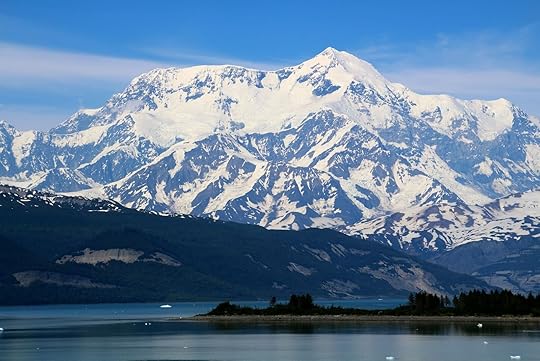
Photo: jet 67/Shutterstock
Mount Saint Elias, straddling the border between Alaska and Canada’s Yukon Territory, stands as North America’s second-highest peak, reaching an elevation of 18,008 feet. Danish-born Russian explorer Vitus Bering is credited with discovering the mountain on July 20, 1741, which is considered the “Feast Day of St. Elias” — hence the name.
The only problem with that is that Bering didn’t discover Mount Saint Elias. The indigenous Tlingit people had already named the mountain “Yasʼéitʼaa Shaa” or “Was’eitushaa,” translating to “mountain behind Icy Bay,” thousands of years earlier. As of early 2025, there are no official movements underway to restore the traditional name, though the National Park Service acknowledges the name “Was’eitushaa” in many of its official public materials.
Today, Mount Saint Elias is split between Wrangell-St. Elias National Park on its US side, and Kluane National Park and Reserve on the Canadian side. While summiting the mountain itself is a formidable challenge only for experienced mountaineers, the surrounding areas provide a wealth of activities. You can see Was’eitushaa from several visitor centers in the park, including those at the historic Kennecott Copper Mine. Many trails around the park offer stunning views of the Wrangell Range, though plenty of flightseeing tours are also available from companies like Wrangell Mountain Air, for visitors who don’t have time to make the long journey into the remote park.
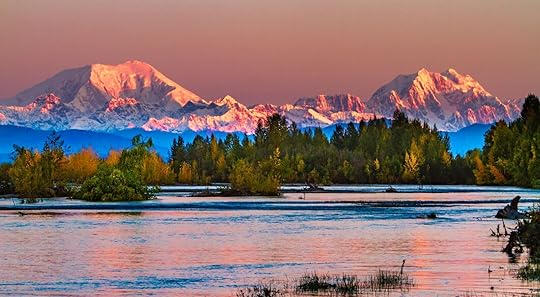
Photo: Bob Pool/Shutterstock
Mount Foraker, standing at 17,400 feet, is the third-highest peak in the United States, just after Denali and Mount St. Elias. It’s also close to Denali, located just about 14 miles to the southwest. That’s probably why the Indigenous Koyukon people called it either “Sultana,” meaning “the woman,” or “Menlale,” meaning “Denali’s wife.” Despite this, in 1899, a US Army lieutenant renamed it Foraker, in honor of a US senator also from Ohio. Like Mount St. Elias, there are no official efforts underway to rename it, though many Alaskans continue to honor the traditional name Sultana.
Like nearby Denali, summiting Mount Foraker is a task best reserved for experienced, high-level mountaineers. However, anyone can see the snow-capped peak from quite a ways away. Around Talkeetna (the gateway town to Denali National Park), there are great views from the Talkeetna Spur road just south of town and from Talkeetna Riverfront Park. However, you can often see Mount Foraker from as far away as Anchorage, given its massive scale. There are excellent views of the range from within Chugach State Park (about 30 minutes from Anchorage) and from the summit of the city’s Flattop Mountain. You’ll have excellent views if you drive the George Parks Highway between Anchorage and Fairbanks, too.
Where to stay: The Most Popular Airbnbs Within Driving Distance to Denali National Park

Photo: reisegraf.ch/Shutterstock
At a roughly three-hour drive from Anchorage, Seward is one of the most popular tourist towns in Alaska. Not only is it in a gorgeous coastal setting on the tip of Resurrection Bay, but it’s also the gateway to Kenai Fjords National Park. It was named Seward in 1903, in honor of William H. Seward. He was the Secretary of State under President Andrew Johnson and orchestrated the purchase of Alaska from Russia in 1867.
Before 1903, the area was called “Qutalleq,” named by the Indigenous Alutiiq people and meaning “Big Beach” in their language. In 1902, the founder of the Central Alaska Railway decided to route a railroad through the area, renaming it Seward as he thought it needed a more “official” name. Many people of Alutiiq heritage still live in Seward, which is also home to the Alutiiq Pride Marine Institute research facility.
Today, Seward sees about 250,000 visitors a year, most of whom come in the summer to visit the park or take advantage of the area’s fantastic recreational fishing. Visitors in 2025 can attend the quirky Seward Mermaid Festival in May, or take advantage of summer tours ranging from Kenai Fjord day tours to whale- watching trips, fishing expeditions, or even guided overnight camping trips on nearby coastline.
Where to stay: 11 Airbnbs in Alaska for a Gorgeous Summer Vacation

Photo: Danita Delimont/Shutterstock
In 1794, a survey team from the H.M.S. Discovery, led by Captain George Vancouver, documented the area as a mere indentation in the coastline, filled mostly by a massive glacier extending over 100 miles from the St. Elias mountain range. By 1879, naturalist John Muir observed that the glacier had retreated more than 30 miles, revealing a bay. That transformation inspired the name “Glacier Bay,” which was officially given to the region in 1880 by a US Navy captain.
Well before the late 1700s, the Huna Tlingit had occupied the area. They called it “S’e Shuyee” or “edge of the glacial silt.” But according to park historians, around the year 1700s, the glacier began to move forward, quickly forcing the Huna Tlingi away from their homes. They returned decades later when the glacier had receded, at which point the land had been carved into a huge valley. At this point, they renamed it “Sit’ Eeti Gheeyi” or “the bay in place of the glacier.”
In 1925, then-President Calvin Coolidge declared it a national monument, and it was designated as a UNESCO World Heritage Site in 1979. It became Glacier Bay National Park and Preserve in 1980, and a UNESCO biosphere reserve in 1986. Since 1994, it’s been co-managed between the National Park Service and Indigenous land owners.
For visitors to the Bay, exploring by boat is one of the most popular options, with tours that range from large cruise vessels to small-group kayak excursions. However, there’s a huge range of on-land activities, too, including hiking trails that meander through lush temperate rainforests and along rugged coastlines. Wildlife watching around the coastlines is also hugely popular.
Birdwatchers will be glad to know the protective efforts of Indigenous, state, and federal agencies have kept the park’s environment in pristine condition, and more than 27 species of bird have been recorded within its boundaries. Anyone interested in learning more about the region’s fascinating geologic and cultural history should visit the Huna Tribal House, which hosts guided programs and cultural demonstrations during the summer months. 
Rocky Mountain Highs at Omni Interlocken: A Family-Friendly Basecamp for Colorado Adventure

We hope you love the stays we recommend! Just so you know, Matador may collect a small commission from the links on this page if you decide to book a stay.
One of my favorite parts about travel is arriving at a place with views that put even the most beautiful landscape photography to shame. Rarely, however, does this happen in a hotel room. Opening the double doors to my suite at the top of the Omni Interlocken in Broomfield, Colorado, and being greeted by a wall-to-wall balcony overlooking the Rocky Mountains was an exceptions.
Omni Interlocken was just finishing a renovation that started in 2019 when I arrived in late November of 2024. The whole building got a refresh from the rooms to the restaurants to the common areas, including the 1,000-square-foot Omni Suite. The room is the apex of the hotel’s offerings, as well as of the building itself on the mountain-facing side of the building.

Photo: Omni Interlocken
Golfers may be familiar with the Omni Interlocken for its 27-hole championship golf course. It even has the distinction of being the spot of a golf world record: Patrick Koenig set the record for the most 18-hole courses played in a year in 2023 and finished his feat at the Omni Interlocken Golf Course. I’m not even a passable golfer. Still, I found plenty else to keep me engaged, relaxed, and in total escape mode on a weekend trip that was one part staycation, one part getaway to celebrate learning kid number two was on the way.
The sprawling resort opened in 1999, and is known for golf, the double pools and hot tub, Mokara spa, and (this being Colorado) proximity to plenty of hiking and biking trails. Its location at the Interlocken business park caters to travelers, golfers, and leisure travelers looking to be close enough to the city centers of Denver and Boulder while still feeling removed from it all.

Photos: Nickolaus Hines
After taking in the landscape view, my eyes wandered to the pool sticks with fresh tips hanging on the wall and the dining table that converts into a full-size pool table directly inside from the balcony. I handed my 2-year-old the vintage-style billiards book to look at the drawings and set up a game for me and my wife. It was far from the typical game at a dingy bar, to say the least.
I’ve gotten used to sweeping mountain vistas at just about every turn since moving to Denver in 2020. Still, the postcard-worthy sight kept me gazing out the sliding doors to the balcony. I almost felt bad for the photographer who captured the breathtaking shot of the Rockies hanging in the adjacent living room. Though it did give me some reassurance that even the professionals can’t capture what I was so enthralled with. (Of course, that didn’t keep me from trying my best at documenting the setting sun as it cast a fire of colors onto clouds framed the mountains.)
Book NowRooms at Omni Interlocken Photo: Omni Interlocken
Photo: Omni Interlocken Living room in the suite. Photo: Omni Interlocken
Living room in the suite. Photo: Omni Interlocken Bedroom in the Omni Suite. Photo: Omni Interlocken
Bedroom in the Omni Suite. Photo: Omni Interlocken Suites have a wet bar area for entertaining. Photo: Omni Interlocken
Suites have a wet bar area for entertaining. Photo: Omni Interlocken Photo: Omni Interlocken
Photo: Omni InterlockenThe Omni Suite may be the premier accommodation at the hotel and the only one with a dining table for eight that doubles as a pool table, but the rest of the rooms got a makeover as well in the renovations. The VIP One Bedroom Suites covers 590 square feet with views of either the Rocky Mountains or the golf course. Like the larger Omni Suite, these have a separate living room, dining area, wet bar, private balcony, and oversized wardrobe.
Outside of the suites, there are 300-square-foot Deluxe Rooms with either a king- or queen-sized bed. The Premier Rooms are a similar size on the higher floors of the building, with king- or queen-sized bed options and custom wall coverings depicting Colorado recreational scenes.
An outdoorsy Colorado theme runs throughout the hotel and rooms. Little wildlife sculptures stand on furnishings, landscape photography of local favorites hang on the walls, and photo books are stacked on the side tables.
Dining at Omni Interlocken Shep's. Photo: Omni Interlocken
Shep's. Photo: Omni Interlocken The Camper. Photo: Omni Interlocken
The Camper. Photo: Omni Interlocken The Camper. Photo: Omni Interlocken
The Camper. Photo: Omni Interlocken Photo: Omni Interlocken
Photo: Omni InterlockenThe location of the hotel doesn’t lend itself to quick meals at local restaurants, but there are a number of dining options focused on local ingredients on the property post-renovation:
The Camper: Comfort food for breakfast and brunch with bottomless mimosas and family-style, all-you-can-eat Camper Breakfast.
Shep’s: Lunch, dinner, and Sunday supper are served in this mountain-chic restaurant serving dishes inspired by Colorado ingredients and a drinks list with spirits, cocktails, and local craft beer.
Trail & Trade: The onsite coffee stop featuring Silver Canyon coffees and local beverages alongside convenient breakfast and lunch options.
Fairways Restaurant: Casual dining on an outdoor terrace with panoramic views of the course and lake.
H20 Poolside Bar & Grill: Pool drinks and meals to refresh any pool day.
Things to do at Omni InterlockenThis is a championship golf resort, so it goes without saying that anyone who wants to play a round or two is in the right spot. Omni Interlocken is for more than just golfers, though.
We indulged in Omni Interlocken’s Babymoon Bliss Package: a stay (typically in the VIP One Bedroom Suite), a 90-minute couple’s massage, a prenatal yoga class designed for stress relief and improved circulation, and a private poolside cabana.

Photo: Omni Interlocken
I thought that I knew people who really enjoy hotel pools until I had a kid and saw the pure joy she gets spotting a body of water to splash and play in. The November air already had a notable chill when we visited and steam floated off the surface, but the two heated pools were warmed to just the right temperature to be comfortable playing for a few hours (and a hot tub for when deeper warmth was needed). Blankets kept us cozy while we enjoyed bites from the fruit and dessert plates in our cabana. In the warmer months, a poolside bar and grill slings drinks and classic pool food, and a little man-made river flows next to the pools.

Photos: Nickolaus Hines
Just inside, the 24/7 fitness center is equipped like a solid neighborhood gym with various yoga and HIIT classes. Get Fit Kits can be acquired from the front desk if you’d rather get your exercise in the privacy of your room, or a complimentary shuttle can take guests to the Rocky Mountain Sports Club Studio for more class offerings.
My wife enjoyed a relaxing treatment at the spa (not yet in her second trimester at the time, the full prenatal massage wasn’t an option), and then a refreshing morning yoga session the next day that stretched out all of the kinks that come with getting a toddler to sleep in a new environment.
Things to do off the propertyOmni Interlocken can be a self-contained trip unto itself. If you don’t want to venture off the property for a few days, there’s really no need to, and on our trip we indeed spent most of the time exploring what Omni has to offer onsite. Like any home base for travel, though, a stay is best rounded out with some exploring of the immediate region.
Activities can be set up through the hotel. As part of the babymoon package, we opted for a guided nature walk on the trails around the Flatirons in Boulder.
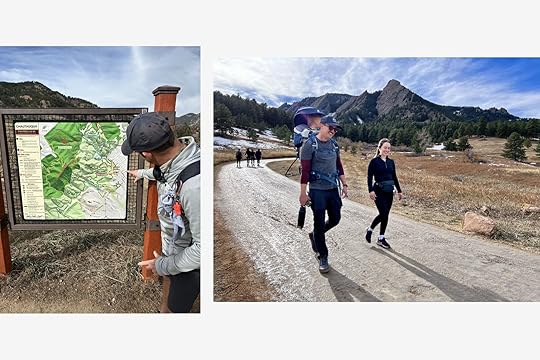
Photos: Joe O’Leary
Our guide Joe O’Leary, with Colorado Wilderness, started doing guided tours in 1993 in West Virginia and moved to Boulder in 2000. Since 2017, he has led excursions at every level with the Colorado Wilderness team, including trips with corporate groups staying at the Omni. Colorado Wilderness takes a “choose your own adventure” approach rather than “pick from this list of options.” Our parameters? Something easy enough to do for someone with moderate fitness level while toting a 27-pound toddler in a carrier on my back. Ideally not too much ice.
O’Leary drove us the short distance to Chautauqua Park in Boulder near the Flatirons, which has been public land since 1898. It’s a quintessential Boulder destination for locals and visitors alike, and we’d traversed a few of the many trails that sprawl out from the park over the years. Hitting the trails with a guide brought a new level of enrichment filled with notes on the outdoor culture in Colorado, the history of the park, and explanations of the geological movements that created the Front Range scenery we walked on. It’s also nice to have someone to take pictures, of course.
Driving back to the hotel, it was clear that O’Leary has a passion for the outdoors and a deep understanding of how nature draws people to Colorado. Staying at the Omni Interlocken, evidence of that draw was all around us. 
This Off-Grid North Carolina Treehouse Is the State’s Cutest Airbnb

Deep in the rolling hills of North Carolina, Flowertown Charm Off-Grid Treehouse offers a true escape from the hustle and bustle of daily life. As the sun set, we arrived at Flowertown Charm, tucked away in the hills near the quaint town of Canton. The final stretch of the drive took us up a half-mile incline, winding through picturesque woods until we reached the treehouse. As we parked and stepped out, the calm crisp air immediately set the tone for our stay.
Traveling in the South? Check out Matador’s accommodations guides: Gorgeous Tennessee Airbnbs across the state for your next southern roadtrip The best Airbnbs in Nashville for a bachelorette getaway The 11 best Nashville Airbnbs by neighborhood 15 Gorgeous Airbnb Cabins in the Smoky Mountains for a Cozy Getaway Escape To These Dreamy Gatlinburg Airbnbs High in the Smokies These Airbnbs in Savannah, Georgia, Put You Close To Downtown, the River, and the Beach 9 Perfect Atlanta Airbnbs To Experience the Best of the City The best Atlanta airport hotels Book these gorgeous Birmingham Airbnbs near the heart of the city Why it’s more important to visit Alabama now than ever Gulf Shores Airbnb rentals near the beach and the best of the city
We checked in and quickly set to work starting a fire to warm up the cozy space. The sun had already set by the time we got settled, leaving us surrounded by darkness. When morning came, the light revealed just how incredible the views were — rolling hills stretched out as far as the eye could see, and the treehouse felt like it was perched in its own private slice of heaven.
We hope you love the Flowertown Charm Airbnb! Just so you know, Matador may collect a small commission from the links on this page if you decide to book a stay.
A treehouse that’s really a treehome
@epic.stays A dreamy treehouse escape where highland cows roam just outside your door@FlowertownCharm OffGrid Treehouse @Joanna | Travel Creator #airbnb #airbnbfinds #asheville #usatravel ♬ Stompin At The Savoy – Benny Goodman
Inside, the warmth and charm of the space made it clear this wasn’t your average treehouse. It was tastefully designed with unique lighting, decorative pillows, and dream catchers that added a personal touch. The wood-paneled walls and soft lighting created a soothing ambiance, while oversized windows invited the outdoors in. Every detail had been thoughtfully cared for. The lofted bedroom was as comfortable as it was charming, with plush linens and a mattress that made it hard to leave in the mornings.
The kitchen had everything we needed to prepare hearty meals, and the wood-burning stove quickly became the heart of the living space. It wasn’t just practical; it added a comforting warmth that made the cabin feel even cozier. Solar power provided electricity, and a generator ensured power was always available. While the outdoor shower wasn’t operational in the winter, the indoor amenities — including a fully functional toilet and a propane heater — made our stay incredibly comfortable. Outside, the balcony offered breathtaking views, complete with rocking chairs that made it the perfect spot to sip coffee and soak in the stillness.
Meet the gentle giants
@epic.stays Living off-grid in a cozy treehouse with highland cows as your neighbors @FlowertownCharm OffGrid Treehouse @Joanna | Travel Creator #airbnb #airbnbfinds #asheville #usatravel ♬ Home – Matthew Hall
One of the most magical aspects of Flowertown Charm is its four Highland cows. These gentle giants roam the 23-acre property and are as friendly as they are photogenic. We spent time feeding and petting them, even brushing their thick coats. It’s not every day you can say you’ve shared a morning with Highland cows, and it was an experience we’ll never forget.
Getting here and exploring the areaWhile the treehouse itself is a retreat, there’s plenty to do nearby if you’re up for exploring. The quaint town of Canton is just a short drive away, offering charming local shops and dining options. If you’re looking for more excitement, Asheville is only 45 minutes from the treehouse. Known for its vibrant arts scene, world-class dining, and the iconic Biltmore Estate, Asheville is a great day trip destination. Nature enthusiasts are in for a treat, as Western North Carolina, boasts a variety of trails perfect for hiking, exploring, and soaking in the stunning landscapes.
Flowertown Charm is conveniently located 45 minutes from Asheville Regional Airport. The drive to the treehouse takes you through scenic countryside, past winding roads and charming small towns. 
January 28, 2025
Nortehaus Offers A Hidden Winter Escape Near Toronto

Arriving at Nortehaus, near Kawartha Lakes in southern Ontario, Canada, felt like stepping into a scene from a movie. The snowy, winding road leading to the house was mesmerizing, with towering trees dusted in white and a serene stillness that set the tone for the perfect winter getaway. Tucked away just two hours from Toronto, this Nordic- and Japanese-inspired retreat offers the tranquility of nature paired with cozy, minimalist luxury.
We hope you love Nortehaus! Just so you know, Matador may collect a small commission from the links on this page if you decide to book a stay.
A peek inside Nortehaus
Traveling to Canada? Check out Matador’s Canada accommodations guides The Most Chic Montreal Airbnbs in the City’s Coolest Neighborhoods The Best Airbnbs in Calgary For City Life and Mountain Escapes The Best Airbnbs in Vancouver, From a Skyhigh Loft To a Beachside Cabin The perfect Vancouver hotels to experience the best of the city 13 Epic Airbnbs in Montreal for a Bachelorette Weekend
@epic.stays POV: You escape to a Nordic and Japanese-inspired Airbnb nestled in nature @nortehaus #airbnb #airbnbfinds #traveltiktok #canada ♬ New Home – Frozen Silence
From the moment you step inside, Nortehaus feels like a warm hug on a snowy day. Perched among the trees and overlooking the river, the home embodies a harmonious blend of Nordic and Japanese design principles, focusing on simplicity and a deep connection to nature. The primary bedroom is a standout feature, offering a luxurious bathtub with river views, a plush queen-size mattress, and a sleek ensuite bathroom with a rainfall shower. It’s a space where you can truly unwind.
The open-concept living, dining, and kitchen area is designed to bring the outdoors in, with expansive floor-to-ceiling windows that showcase the surrounding natural beauty. The kitchen is thoughtfully equipped with all the essentials for preparing a comforting meal. Just off the kitchen, the second bedroom provides a cozy retreat with a comfortable queen bed and an ensuite bathroom.
The outdoor patio and sauna seamlessly extend the home’s calming atmosphere into the forest. The sauna, crafted with a striking Shou Sugi Ban exterior — a Japanese wood-burning technique — offers a tranquil and unique space to unwind. For more outdoor relaxation, take a short stroll to the riverfront, where you can enjoy a refreshing swim in the summer or a brisk cold plunge during the cooler months.
Getting to Nortehaus and what to do during your stay
@epic.stays This cabin is only a 2-hour drive from #Toronto @nortehaus @Joanna | Travel Creator #airbnb #airbnbfinds #traveltiktok #canada ♬ original sound – Full Crate
Nortehaus is a place to slow down, leave your devices behind, and savor the moment. Relax in the freestanding soaking tub in the main bedroom while enjoying serene river views, or unwind in the outdoor sauna surrounded by crisp winter air. The house invites you to connect with nature and find peace in its cozy, minimalist spaces. Just a short drive away, Indian Point Provincial Park offers year-round activities that make Nortehaus a true four-season escape. In the summer, you can rent a canoe and paddle through serene waters. The fall brings a spectacular display of changing leaves, while winter offers the chance to go snowshoeing through the park’s trails. Every month at Nortehaus offers a new way to connect with nature and embrace the season.
Getting to Nortehaus is part of the adventure. The two-hour drive from Toronto Pearson International Airport takes you through picturesque snowy landscapes. Just make sure your car is winter-ready for the final stretch near the house. 
This Spanish City Rivals Barcelona for Food and Culture, Without the Crowds
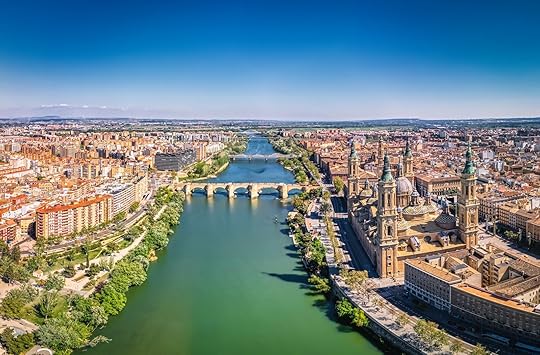
Madrid, Barcelona, Seville, and Málaga leap out as the usual suspects for cities to visit in Spain. As these hotspots grapple with overtourism, casting the net wider can pay off. Zaragoza, the capital of the Aragon region in the country’s northeast, is one such place that has, to date, escaped the limelight. Lying halfway between Barcelona and Madrid, Zaragoza is both a practical option for a stopover and a place where you can catch your breath without the crowds.
There are enough sites to fill a day or two in this walkable city which has a history as diverse as the tapas scene. First came the Romans, in the 1st century BC. Named after the first Roman Emperor, they established the city of Caesaraugustus and set about constructing facilities for entertainment and trade which now form the benchmark of tourism. The Moors followed, renaming the city as Saraqusta and erecting buildings in the Mudéjar style, including Aljafería Palace which is open to tours. Zaragoza’s other appeal lies in its astounding churches and art museums. Francisco Goya hails from the nearby town of Fuendetodos although Zaragoza claims him as one of their own and has a museum dedicated to his work and that of his mentees.
Zaragoza’s treasures and ruins
Photo: Anibal Trejo/Shutterstock
The is dominated by the Basilica of Our Lady of the Pillar, a Baroque masterpiece presiding over its namesake square on the banks of the River Ebro. Legend says that Mary appeared to Saint James at this location and instructed the construction of a church in her honor. The atmosphere inside and in the plaza is particularly magical at night and the views from the Stone Bridge (Puente de Piedra) are splendid around dusk. This cathedral is joined by La Seo, the Cathedral of the Savior, which is part of the Mudéjar Architecture of Aragon World Heritage Site.
Recovered as recently as the 1970s, Zaragoza’s amphitheater is the starting point for the quartet of Roman museums to which a combined pass costs only €7 (about $8). Walkways cut through the archaeological zone, allowing a closer look at the foundations and providing a sense of scale. The theater is accompanied by four floors of museum exhibits explaining the uses of the arena and digging into the culture of performance in ancient times.
The Museum of the Theater of Caesaraugusta is joined by three additional Roman points of interest. The Roman Baths Museum is the smallest of the group while the Caesaraugusta River Harbor Museum demonstrates how the river’s water levels have receded over the centuries. The Museum of the Forum of Caesaraugusta preserves the nucleus of the ancient Roman city and lets you wander through partially excavated tunnels.
These museums are all close enough to get around over the course of a few hours without feeling the pressure of a strict itinerary or having to faff with public transport. Even better, each one can be punctuated with a tapas stop.
Tapas and pintxos in Zaragoza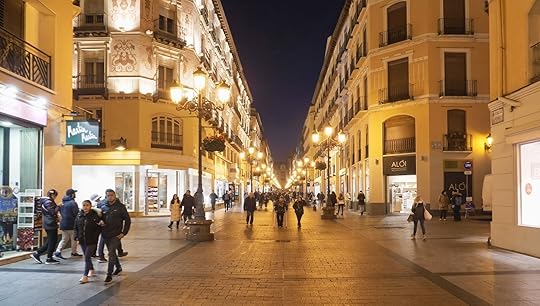
Photo: MEDIAIMAG/Shutterstock
Tapas bars in Zaragoza have a more intimate feel compared to other large cities. Menus tend to be in English but most of the tapas and pintxos plates are displayed at the counter to make things easier. Torreznos, fried pork with a similar texture to bacon, is a specialty to look out for although most menus are seafood-heavy.
The El Tubo enclave marks the heart of the Zaragoza tapas scene. Where you will eat in this warren of narrow alleys ultimately depends on where there is a spare table or a place to perch – the best thing to do is hop along and try the signature tapa at each tavern. Bar El Champi serves only one pintxo and it excels. This is three plump portobello mushrooms skewered on a wedge of bread, drizzled in garlic sauce, and topped off with a prawn. Right across the street, croquettes are the main reason to make a pitstop at Taberna Doña Casta. These are cooked to order and the croquetas de bacalao (cod) should be prioritized. Plates of huevos rotos come in handy for larger appetites.
Beyond the bustling El Tubo, you’ll find even more foodie spots. El Trujalico was one of my favorites, owing to the variety of tapas and the fixed menu. Sit at the bar where you can browse scallops in their shells, anchovies curled around olives, oysters, and strips of salted cod mingled with padron peppers. Head to Casa Dominó for dinner and order a spread of gratinados and montaditos (mini baguettes) to split.
If you like to plan your foodie stops when traveling, you’ll want to make a note of the opening days and hours. Most restaurants close a couple of days each week and they operate two shifts per day with a good number starting the dinner service after 8:00 PM.
Getting to Zaragoza
Photo: WINDCOLORS/Shutterstock
Fast trains take one hour and thirty minutes between Zaragoza and either Madrid or Barcelona. It’s just about do-able to hop off and spend a day seeing the main sites. However, spending a night or two allows more time to enjoy the tapas scene and tap on an outing to the Pyrenees or a wine tasting in Cariñena.
One thing to know about Zaragoza: having at least some basic Spanish goes in your favor. Very few of the museums and menus carry English translations and audio guides aren’t a thing. This adds to the charm of the city and even knowing a couple of words goes a long way in this friendly city. 
The Most Stunning Airbnbs to Book for March

March is one of my favorite months to get away. The stress of the holiday season is long forgotten; nature is waking up, temperatures are warming, and rates are reasonable — the shoulder season offers decent deals on flights and accommodation before the mad rush of Easter. These Airbnbs are some of the best to book in March if you want to see stunning springtime blooms, visit National Parks without the crowds, do some world-class whale watching, and attend noteworthy events. And you don’t need to go too far because these effortless getaways are all in the US.
Catch the tail end of whale watching season in Maui Photo: Airbnb
Photo: Airbnb Photo: Airbnb
Photo: Airbnb Photo: Airbnb
Photo: Airbnb Photo: AirbnbSee more photos
Photo: AirbnbSee more photosMarch is still within the prime whale watching season (December — May), offering excellent opportunities to spot humpback whales migrating through Hawaiian waters. The weather is pleasant, too, with average highs in the mid-70s. Maui’s high season is also coming to an end by then, so you might find there are some last-minute flight deals.
When it comes to choosing where to stay, Maui’s beachfront resorts are likely to have a few rooms at reasonable rates, but your best bet is an Airbnb, and for that, you’ve got options galore, including some mega beachfront properties.
Although you’d need to travel half an hour or so to the ocean for whale spotting, this property in Olinda (around two miles southeast of Makawao) is a haven for nature lovers. It’s also a top 10 percent Airbnb listing. The one-bedroom cottage has a deck with a soaking tub and killer views over the island. The host promises an elegant and laid-back island stay.
Two guests, one bedroom
Price: $397 per night
 Photo: Airbnb
Photo: Airbnb Photo: Airbnb
Photo: Airbnb Photo: Airbnb
Photo: Airbnb Photo: AirbnbSee more photos
Photo: AirbnbSee more photosYou’ll either love or despise the suggestion of Miami during spring break. If you’re not cringing, let’s party. Miami is buzzing in March; temperatures are around the mid-70s, cultural events are on every corner, beaches are packed, and pool parties are endless.
If you want a hotel, I stayed at Pharrell Williams’ The Goodtime Hotel in March a couple of years back, and it was wild. One thing I didn’t love, though, was the sound of people in the hallway at 3 AM, so if you’re a light sleeper or would just rather have a baller pad of your own, look to the city’s Airbnbs.
If you have a group, check out this four-bedroom villa. It’s ticking all the boxes. There’s a pool, terrace views of the open bay and Miami skyline, a Sonos sound system, and an outdoor grill.
Due to spring break, it’s worth noting that many Airbnbs in Miami have a “no party” rule. But don’t let that put you off, there’s enough going on in the city for entertainment and you’ll be grateful for a beautiful haven to retreat to once the sun comes up.
Eight guests, four bedrooms
Price: $1,867 per night
 Photo: Airbnb
Photo: Airbnb Photo: Airbnb
Photo: Airbnb Photo: Airbnb
Photo: Airbnb Photo: AirbnbSee more photos
Photo: AirbnbSee more photosArizona is a playground in springtime for outdoor sports. Many say it’s the state’s way of apologizing for cold winters and unbearably hot summers. There’s bags of sunshine, the desert is coming to life with cacti, and cool mornings and management mid-day heat mean you have longer in the day to enjoy activities like hiking, biking, kayaking, and canyoneering.
Where you base yourself comes down to what you want to do, but you really don’t need to tie yourself in knots considering a location. Choosing an Airbnb that suits your needs first can be a better way to go around it, especially if it’s surrounded by an epic landscape or a jumping-off destination like Phonix. March is the prime season for exploring the Sonoran Desert, and snagging a lush pad in the city will offer you a retreat near amenities after a sporty day.
For a modern stay, check out this three-bedroom architect-designed luxe home. Perfect for a group, the Airbnb has an outdoor paradise with a heated pool, fireplaces, and a private putting green.
Six guests, three bedrooms
Price: $698 per night
 Photo: Airbnb
Photo: Airbnb Photo: Airbnb
Photo: Airbnb Photo: Airbnb
Photo: Airbnb Photo: AirbnbSee more photos
Photo: AirbnbSee more photosI’m also thrilled to say that we are galloping towards cherry blossom season. And although March is a smidge early for blooms to be at their showiest, across the US, parks and gardens will be coming to life. While the “Cherry Blossom Capital of the World” is in Macon, Georgia, Washington puts on an equally impressive show.
Aim for the end of March to see the trees in bloom around the steps of the Jefferson Memorial, the Martin Luther King Jr. Memorial, the Japanese Lantern, the US National Arboretum, the Dumbarton Oaks Gardens, Hains Point Loop Trail, The Basilica of the National Shrine of the Immaculate Conception, and the Tidal Basin.
Washington, D.C.’s Airbnbs come in all shapes and sizes, but the site’s Design Category is a lovely place to start.
This historic East Village townhouse was built in 1850 and offers 15-foot ceilings, abundant natural light, and a perfect balance between contemporary and historical elements. Each bedroom has an en-suite bathroom, while the master suite has a private terrace and a separate dressing room. You’ll have exclusive access to the top three floors of the townhouse and a secluded garden.
Eight guests, three bedrooms
Price: $504 per night
 Photo: Airbnb
Photo: Airbnb Photo: Airbnb
Photo: Airbnb Photo: Airbnb
Photo: Airbnb Photo: AirbnbSee more photos
Photo: AirbnbSee more photosMacon enjoys an earlier start to its cherry blossom season than many other regions, with 350,000 Yoshino trees typically reaching peak bloom in mid-to-late March. The annual Cherry Blossom Festival, aptly dubbed “The Pinkest Party on Earth,” commences officially on March 15 and concludes on March 24. However, the festive spirit permeates the city weeks beforehand, with businesses adorning their windows in pink and floral motifs and the town fountain taking on a vibrant fuchsia hue.
There are a few excellent Airbnbs in Macon itself. Still, if you’d rather be a smidge more remote, I recommend staying on Lake Tobesofkee, where you’ll have peaceful surroundings and walkable opportunities for water sports or relaxed days on the beach. The lake is around 20 minutes from Macon, so you can easily pop in for festivities, too.
This stunning secluded lake house retreat offers a luxurious escape with breathtaking 180-degree sunset views of Lake Tobesofkee. Situated on two private acres with 200 feet of lake frontage, the property has a private dock, a three-tiered deck with a hot tub and fire pit, and a range of water sports equipment, including canoes, kayaks, and paddleboards. The spacious 3,300-square-foot home features five bedrooms, three and a half bathrooms, a fully equipped kitchen, a game room with an 85-inch theater screen, and a dedicated office space if you “need” to work.
16+ guests, five bedrooms
Price: $474 per night
 Photo: Airbnb
Photo: Airbnb Photo: Airbnb
Photo: Airbnb Photo: Airbnb
Photo: Airbnb Photo: AirbnbSee more photos
Photo: AirbnbSee more photosDespite the recent wildfires, California needs tourism. You’ll need to plan accordingly, but your tourism dollars will help rebuilding efforts. And springtime in the state is magical, especially if you love wildflowers.
The Antelope Valley California Poppy Reserve in the Mojave Desert offers a breathtaking spectacle each spring. While the exact timing of the bloom varies depending on rainfall and temperature, the reserve typically comes alive with carpets of the California poppy from mid-February through May. Peak bloom generally occurs in late March or early April, but it’s worth checking out the reserve’s official website or social media channels for the latest updates. You can explore the eight miles of trails that wind through the rolling hills at the park. The trails cater to various fitness levels, including a paved wheelchair-accessible section.
For a nearby stay, check out this spacious three-bedroom, two-bathroom home in the heart of Tehachapi. You’ll be perfectly positioned to explore the reserve from this base and it’s also a short drive from some of the region’s finest vineyards. The highlight of Airbnb has to be its stunning views over the nearby mountains and exceptional stargazing conditions — perfect for an outdoorsy family getaway.
Six guests, three bedrooms
Price: $367 per night
 Photo: Airbnb
Photo: Airbnb Photo: Airbnb
Photo: Airbnb Photo: Airbnb
Photo: Airbnb Photo: AirbnbSee more photos
Photo: AirbnbSee more photosThe Great Smoky Mountains National Park, often referred to as the “Wildflower National Park,” has an astonishing diversity of plant life, with over 1,600 species calling this unique ecosystem home. As spring awakens the mountains, a tapestry of wildflowers transforms the landscape into a breathtaking spectacle.
March marks the beginning of this wildflower season, with a succession of early bloomers gracing the forest floor. Among the first to emerge are the delicate Spring Beauty, identifiable by its dainty pink-striped petals that bloom in white or pale pink shades. The Trout Lily, named for its distinctive spotted leaves that resemble the markings of a brook trout, also makes an early appearance. These 6- to 8-inch-tall plants produce solitary, drooping yellow flowers, adding a splash of color to the spring landscape. Explore the Porters Creek Trail or the Cove Hardwood Self-Guided Nature Trail to witness these early bloomers.
Choose a stay with some character to complement your exploration of the park, such as this custom-built tiny cabin 25 minutes from the Smoky Mountains. The one-bedroom is ideal for a couple or small family. From here, you’ll have unobstructed views of the sunset and surrounding mountains.
Four guests, one bedroom
Price: $297 per night
 Photo: Airbnb
Photo: Airbnb Photo: Airbnb
Photo: Airbnb Photo: Airbnb
Photo: Airbnb Photo: AirbnbSee more photos
Photo: AirbnbSee more photosThe Grand Canyon Rim-to-Rim hike has one of the most competitive hiking permits in the US, so planning a trip around this route in March might be a long shot. But, the month does offer pleasant temperatures for hiking and exploring, and you’ll witness the canyon in a different light as wildflowers bloom along the rim and add color to the landscape. It’s also one of the most-visited parks in the US, so going in springtime will allow you to enjoy the landscape sans crowds. That also goes for Zion National Park, where the desert floor of a muted palette of browns and reds comes alive with pink, purple, yellow, and orange wildflowers.
Airbnbs near the Grand Canyon are remote. There are no major towns near the park, but there are many jaw-dropping options within driving distance. Now, for something memorable, I’ve found this sprawling desert home on 40-acres in South Zion. But it’s not a quick 30-minute drive from the Canyon. You’ll be looking at around three hours. Stay with me here. It’s an excellent base for visiting both Zion and the Grand Canyon. If you’re an early bird, a day trip to the Canyon is more than doable, and the drive will take you through some of the most impressive scenery in Utah and Arizona.
Four guests, one bedroom
Price: $297 per night
 Photo: Airbnb
Photo: Airbnb Photo: Airbnb
Photo: Airbnb Photo: Airbnb
Photo: Airbnb Photo: AirbnbSee more photos
Photo: AirbnbSee more photosTickets for South by Southwest (SXSW), one of Austin’s hottest festivals in mid-March, are still available. But you’ll need to get a move on. Conference event tickets are $1495, film and TV $1295, and music passes are $845. Or, you can get an all-access pass for $2095 if you want to see (and do) everything. The city will be packed with music, film, and industry leaders, so it’s an excellent opportunity to network. If you love large-scale events, Austin delivers. But you’ll still need to learn how to avoid the chaos. For that, I suggest getting an Airbnb in a peaceful place so you can dip in and out and take the festival at your own pace.
Austin is one of the many cities in the US where you can get stuck down an Airbnb rabbit hole really quickly. For time well spent, filter by Airbnb categories like tiny homes, design, or OMG. This listing is within the OMG section, and it’s hardly surprising why. It’s located in Westlake Highlands and is described as a “giant seashell, part Willy Wonka, part Big Lebowski.” Although it will feel remote, you’ll only be 15 minutes or so from downtown Austin. Two UT architecture students built the residence as a quirky retreat that works in harmony with the environment. Previous guests state you’ll need to see it to believe it. Bookmark this property for future trips to Austin if it’s unavailable on your dates, and check out Matador’s list of guest favorite Airbnbs in the city for more options.
Four guests, one bedroom
Price: $530 per night
 Photo: Airbnb
Photo: Airbnb Photo: Airbnb
Photo: Airbnb Photo: AirbnbSee more photos
Photo: AirbnbSee more photosNew Orleans is still in the morning of the attack that occurred on Bourbon Street on New Year’s Day. However, the city must recover and restore its joie de vivre, with many large-scale events such as Mardi Gras and the Super Bowl on the horizon. New Orleans and its people are famously resilient, and there will be an increase in federal security resources for all future events. The city relies heavily on tourism, so if you’re considering Mari Gras, do some trip planning beforehand and again book soon if you want a pleasant Airbnb experience.
New Orleans has some wild group-sized Airbnbs. The city caters well to those traveling with families and in mixed groups visiting to celebrate an event. Built in the 19th century, this home was completely renovated in 2022. It’s centrally located between the French Quarter and Garden District and five minutes from the famous St.Charles Streetcar. It ticks all the boxes for a bachelorette Airbnb: A year-round heated pool, outdoor kitchen, tropical landscaping — the perfect backdrop for group pictures — and plenty of space for dining and entertaining. There’s a noise cap between 10 PM and 8 AM, but this rental’s regulation is not unique. The city requires Airbnbs of this size and in this area to be equipped with a noise monitoring device. But, let’s be honest, the ruckus party can happen in one of the bars a streetcar ride away. 
10 guests, five bedrooms
Price: $462 per night
Matador Network's Blog
- Matador Network's profile
- 6 followers



